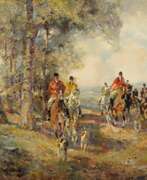Landscape painters Federal Republic of Germany (1949—1990)


Julius Bretz was a German painter of the late nineteenth and first half of the twentieth centuries. He is known as a painter and graphic artist, a painter of landscapes and floral still lifes, a representative of the Düsseldorf and Hague Schools.
Julius Bretz was one of the four founders of the Düsseldorf art association Sonderbund and a founder of the Rhine Secession. He was also a member of the artist association "Malkasten" and a member of the Cologne and Bonn artist associations.
Bretz's paintings can be seen today in art museums in Bonn, Düsseldorf, Cologne, Wuppertal, Zurich and other cities


Hermann Gradl was a German artist of the first half of the twentieth century. He is known as a painter, graphic artist, illustrator and teacher, professor of art.
Hermann Gradl took up painting at the age of 25. He was self-taught, learning from the works of the masters of the Old German and Dutch schools, as well as the romanticized realists of the 19th century. The artist created small- and medium-format idyllic landscapes, urban vistas, and genre scenes. The rise to power in Germany of the National Socialists strengthened Gradl's position, as his work conformed to the cultural policies of the Third Reich. Hitler celebrated him as the best contemporary German landscape painter.
In all, Gradl created more than 8,000 drawings, some 2,100 oil paintings and hundreds of illustrations during his career.


Ludwig Gschossmann was a German artist of the twentieth century. He is known as a painter, landscape painter and genre painter.
Gschossmann produced paintings in the style of realism at the beginning of his career, but gradually moved towards impressionism. He became famous for his landscapes, scenes of social life and domestic subjects. His series of paintings "Neskuchnye Evenings", depicting opera balls in Munich and Baden-Baden, brought him great fame. He is also known for his hunting scenes.


Franz Radziwill was a German artist of the twentieth century. He is known as a landscape painter, graphic artist and printmaker associated with the artistic movement of "new materiality".
Franz Radziwill created paintings that are characterized by careful elaboration and the use of glaze techniques borrowed from the Old Masters. He used elements of industrial buildings and modern technology, including ships and airplanes, in his landscapes. The results of his work can be categorized as magical realism.
In 1933 Radziwill became professor of painting at the Düsseldorf Academy of Art, but in 1935 the Nazis stripped him of this position, declaring his work degenerate art.